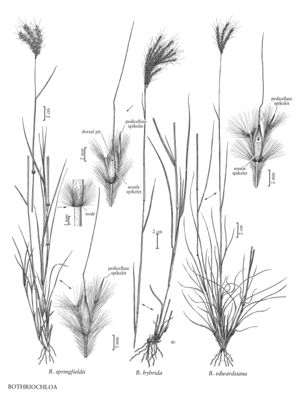Bothriochloa hybrida
Culms 30-80 cm, stiffly erect, moderately branched above the base; nodes glabrous or puberulent. Leaves primarily cauline; sheaths glabrous, green, sometimes glaucous; ligules 1-2 mm; blades 5-25 cm long, 2-5 mm wide, flat to folded, usually ciliate, with long hairs near the base and some hairs on the adaxial surface. Panicles 5-12 cm, lanceolate; rachises usually shorter than 5 cm; branches 3-8, without axillary pulvini, lower branches longer than the rachises; at least the lower branches rebranched and with multiple rames; rame internodes with 5-7 mm marginal hairs. Sessile spikelets 4.5-6.5 mm, narrowly ovate; lower glumes 4.5-5.7 (6.5) mm, sparsely hairy near the base, with a dorsal pit above the middle; awns 18-25 mm; anthers 0.5-1 mm. Pedicellate spikelets 2.2-3.6 mm, sterile. 2n = 120.
Discussion
Bothriochloa hybrida grows in open grasslands, rangeland pastures, disturbed ground, and roadsides, often on calcareous soil, usually at 50-500 m. Its range extends from southern Texas and Louisiana to central Mexico. It resembles B. edwardsiana in some respects, but the latter species has a less robust habit, more predominantly basal foliage, and narrower leaf blades.
Selected References
None.
Lower Taxa
"decumbent" is not a number.
